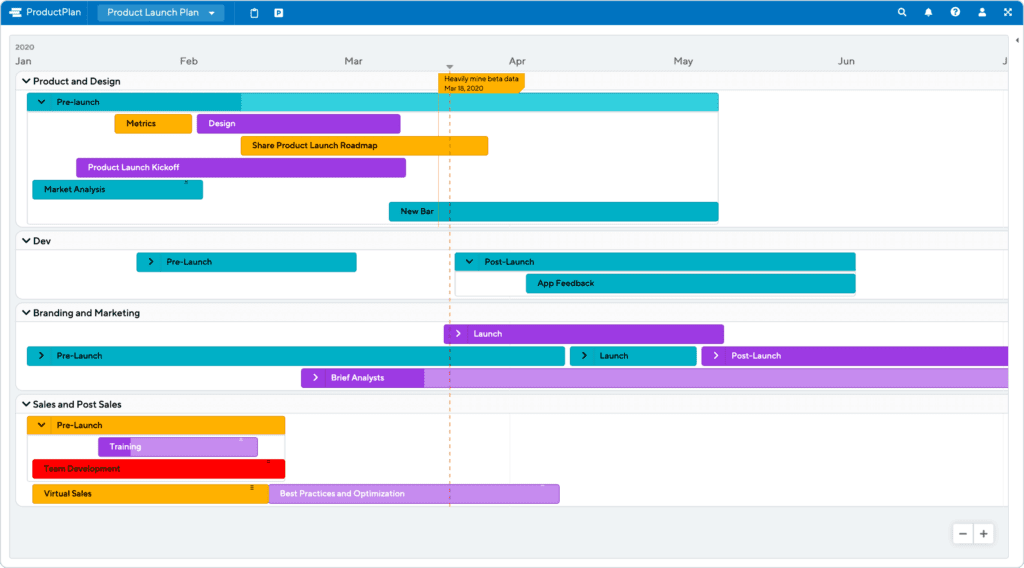Product Management is responsible for driving the development of her company’s products and delivering them successfully to the market. A product manager’s role typically involves managing the day-to-day responsibilities required to execute the strategy and vision set for her products and communicating this strategy to all relevant participants and stakeholders.
As such, a product manager serves as her company’s central hub of product knowledge, market research, customer feedback, and other product details. The following are some basic product management terms and definitions that any product manager should be familiar with.

GTM (go-to-market)
A product’s GTM (or go-to-market) is a strategic plan encompassing the major tactics and resources that a company will use to release, promote, and sell the product. A GTM plan can include details about pricing, sales and distribution channels, marketing, and promotion.
GA (general availability)
GA, or general availability, is the release of a product to the general public. The product becomes available through the company’s general sales channel — as opposed to a limited release, or beta version, used primarily for testing and user feedback purposes.
MVP (minimum viable product)
An MVP, or minimum viable product, represents the earliest stage in the product’s development cycle at which the company believes it has enough features to satisfy early-adopter customers. In industries such as software or for companies with limited funding, the MVP can help the product teams receive user feedback as quickly as possible, which they can use to iterate and improve the product.
Persona
In product management, a persona is a profile of the product’s typical user — and products can have many different personas. Writing up summaries of a product’s personas can help a product manager (and others in the organization involved with the product’s development) understand key traits, behaviors, goals, responsibilities, and needs of a specific type of user.
Product managers often write up various personas — buyer personas, customer personas, and decision-maker personas — to better understand how to meet the needs of these constituencies.
Use Case
A use case is a hypothetical (but plausible) scenario showing how a product’s user might interact with the product to achieve a specific goal. Product managers often employ use cases to explain through easy-to-digest stories how and why customers will use various parts of a product.
BI (business intelligence)
BI, or business intelligence, is a method of compiling, analyzing, and interpreting business data to make better-informed decisions. BI data is typically compiled through extensive research across a wide range of sources — including industry reports, customer feedback, actual usage data of the company’s products, and competitive research.
Agile
Most often found in the software industry but also used by other industries, agile is an iterative product-development methodology in which teams work in brief, incremental “sprints” and then regroup frequently to review the work and make changes. This adds frequent feedback and the ability to switch focus and priority quickly and is in contrast to the more traditional, sequence-based, waterfall methodology, where product managers set long-term plans in discrete phases for development teams to execute.
Sprint
In agile methodology, the sprint is the time period (e.g., 14 days) in which an agreed-upon set of development tasks takes place and is made ready for review. The product and development teams typically begin a sprint with a kickoff planning meeting, and in this meeting, the group agrees to the specific tasks needed to be completed in the sprint.
Scrum
Scrum is an iterative software development framework for managing product development. It defines a flexible product development strategy where a development team works as a unit to reach a common goal. It enables teams to self-organize by encouraging physical co-location or close online collaboration of all team members, as well as daily face-to-face communication among all team members and disciplines involved.
Waterfall
In contrast to agile, the waterfall development model is a long-term method of product development characterized by a sequential series of stages or phases — typically, in order, conception, initiation, analysis, design, construction, testing, implementation, and maintenance. The key distinction from agile is that, in a waterfall development environment, once the work for a stage has been completed, the team cannot turn back, and development must move on to the next stage.
MRD (market requirements document)
An MRD, or market requirements document, is a strategic document written by a product manager to help define the market’s requirements or demand for a specific product. An MRD typically contains information on the product’s vision, the competitive landscape, a business analysis, and revenue opportunity, as well as a list of features or at least high-level feature categories.
BOM (bill of materials)
In the manufacture of physical products, a BOM, or bill of materials, is a complete list of the materials needed to build the product.
Roadmap
In product management, a roadmap is a high-level strategic document that product managers create and maintain to communicate the strategic vision and objectives of the product. Roadmaps can also be used for similar strategic purposes for initiatives other than product development, such as for enterprise IT upgrades, marketing plans, or product launches.
Alpha Test
Used most commonly in the software industry, at the point when development is nearly complete, a product manager will often conduct an alpha test, in which a small group of users will test the product for bugs or other issues.
Beta Test
A beta test is a widespread pre-launch distribution of a product (typically software), in which users are asked to try the product and to provide feedback to help the product team improve it for launch or GA.
Cannibalization
If one product in a company competes directly with another of the company’s products, it is sometimes described as cannibalizing the other product’s sales. This is why product managers responsible for a line or suite of products must work diligently to create distinct value propositions for each product or segment their products by persona, pricing, or other differentiators.
Value Proposition
In product management, a value proposition is a high-level statement, often written as a promise to the customer, about how a product will meet that customer’s needs.
USP (unique selling proposition)
A product’s USP, or unique selling proposition, is its unique competitive advantage, or the reason a customer would select the product over any other. Generally, USPs are written as benefits to the customer or user.



